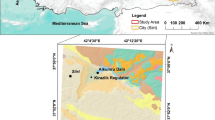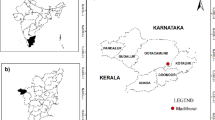Abstract
In this study the factors affecting the retrogressive Yaka Landslide, its mechanism and the hazard of debris flow on the town of Yaka are investigated. In the landslide area, the first landslide was small and occurred in March 2006 on the lower part of the Alaardıç Slope near the Gelendost District town of Yaka (Isparta, SW Turkey). The second, the Yaka Landslide, was large and occurred on 19 February 2007 in the soil-like marl on the central part of Alaardıç Slope. The geometry of the failure surface was circular and the depth of the failure surface was about 3 m. Following the landslide, a 85,800 m3 of displaced material transformed to a debris flow. Then, the debris flow moved down the Eglence Valley, traveling a total distance of about 750 m. The town of Yaka is located 1,600 m downstream of Eglence Creek and hence poses a considerable risk of debris flow, should the creek be temporarily dammed as a result of further mass movement. Material from the debris accumulation has been deposited on the base of Eglence Valley and has formed a debris-dam lake behind a debris dam. Trees, agricultural areas, and weirs in the Eglence Creek have seen serious damage resulting from the debris flow. The slope angle, slope aspect and elevation of the area in this study were generated using a GIS-based digital elevation model (DEM). The stability of the Alaardıç Slope was assessed using limit equilibrium analysis with undrained peak and residual shear strength parameters. In the stability analyses, laboratory test results performed on the soil-like marls were used. It was determined that the Alaardıç Slope is found to be stable under dry conditions and unstable under completely saturated conditions. The Alaardıç Slope and its vicinity is a paleolandslide area, and there the factor of safety for sliding was found to be about 1.0 under saturated conditions. The Alaardıç Slope and the deposited earthen materials in Eglence Creek could easily be triggered into movement by any factors or combination of factors, such as prolonged or heavy rainfall, snowmelt or an earthquake. It was established that the depth of the debris flow initiated on the Yaka Landslide reached up to 8 m in Eglence Creek at the point it is 20 m wide. If this deposited material in Eglence Creek is set into motion, the canal that passes through Yaka, with its respective width and depth of 7 and 1.45 m, could not possibly discharge the flow. The destruction or spillover of this canal in Yaka could bring catastrophic loss to residents which are located within 3–5 m of the bank of the canal. Furthermore, if material present in the landslide source area slides and this displaced material puts pressure on the unstable deposited material in Eglence Creek, even more catastrophic loss would occur to the town of Yaka. In this study, it was determined that debris flows are still a major hazard to Yaka and its population of 3,000. The results provided in this study could help citizens, planners, and engineers to reduce losses caused by existing and future landslides and debris flow in rainfall and snowmelt conditions by means of prevention and mitigation.
















Similar content being viewed by others
References
Anderson SA, Sitar N (1995) Analysis of rainfall-induced debris flows. J Geotech Eng 121:544–552. doi:10.1061/(ASCE)0733-9410(1995)121:7(544)
Benac C, Arbanas I, Jurak V, Ostric M, Ozanic N (2005) Complex landslide in the Rjecina valley (Croatia): origin and sliding mechanism. Bull Eng Environ 64:361–371. doi:10.1007/s10064-005-0002-5
Bishop AW (1955) The use of the slip circle in the stability analysis of slopes. Geotechnique 5:7–17
Boray A, Şaroğlu F, Emre Ö (1985) Isparta büklümünün kuzey kesiminde Doğu-Batı daralma için bazı veriler. Jeoloji Muhendisligi 23:9–20 (in Turkish)
Bowles JE (1992) Engineering properties of soils and their measurement. McGraw-Hill, Inc., New York, pp 241
Chowdhury R, Flentje P (2002) Uncertainties in rainfall-induced landslide hazard. Q J Eng Geol Hydrogeol 35:61–69
Chung CF, Fabbri AG, van Westen CJ (1995) Multivariate regression analysis for landslide hazard zonation. In: Carrara A, Guzetti F (eds) Geographical ınformation systems in assessing natural hazards. Kluwer Academic Publishers, The Netherlands, pp 107–133
Delmonaco G, Leoni G, Margottini C, Puglisi C, Spizzichino D (2003) Large scale debris-flow hazard assessment: a geotechnical approach and GIS modeling. Nat Hazards Earth Syst Sci 3:443–455
Demirkol C (1986) Sultandağ ve dolayının tektoniği. MTA Derg 107:111–118 (in Turkish)
Duman TY, Can T, Gokceoglu C, Nefeslioglu HA (2005) Landslide susceptibility mapping of Çekmece area (Istanbul, Turkey) by conditional probability. Hydrol Earth Syst Sci Discuss 2:155–208. http://www.hydrol-earth-syst-sci-discuss.net/2/155/2005/hessd-2-155-2005.html
Dunning SA, Rosser NJ, Massey CR (2006) Formation and failure of the Tsatichhu landslide dam, Bhutan. Landslides 3:107–113. doi:10.1007/s10346-005-0032-x
ERD (Earthquake Research Department) (2003) http://www.deprem.gov.tr/depyon/DBYBHY-2007.pdf
Fiorillo F, Wilson RC (2004) Rainfall induced debris flows in pyroclastic deposits, Campania (southern Italy). Eng Geol 75:263–289. doi:10.1016/j.enggeo.2004.06.014
Geo-Slope (2000) Geo-Slope office. Geo-slope International Ltd., Calgary, Canada
Glade T (1998) Establishing the frequency and magnitude of landslide triggering rainstorm events in New Zealand. Environ Geol 35:160–174. doi:10.1007/s002540050302
Gülkan P, Yücemen S, Koçyiğit A, Doyuran V, Başgöz N (1993) En son verilere göre hazırlanan Türkiye deprem bölgeleri haritası. ODTÜ Deprem Mühendisliği Araştırma Merkezi, Rapor No. 93-01 (in Turkish)
IAEG Commission on Landslides (1990) Suggested nomenclature for landslides. Bull Eng Geol Environ 41:13–16. doi:10.1007/BF02590202
Ildir B (1995) Türkiyede heyelanların dağılımı ve afetler yasası ile ilgili uygulamalar. In: Önalp A (ed) Proceedings of 2nd national landslide symposium. Sakarya University, Turkey, pp 1–9 (in Turkish)
Janbu N (1968) Slope stability computations. Institutt for Geotknikk og Fundamenteringslære, Norges Tekniske Høgskole, Soils Mechanics and Foundation Engineering, the Technical University of Norway, Trondheim, Norway
KOERI (Boğaziçi University Kandilli Observatory Earthquake Research Institute). Earthquake database, http://www.koeri.boun.edu.tr
Koçyiğit A (1983) Hoyran Gölü (Isparta Büklümü) dolayının tektoniği. Geol Soc Turk Bull 26:1–10 (in Turkish)
Koçyiğit A (1984) Intra-plate neotectonic development in southwestern Turkey and adjacent areas. Geol Soc Turk Bull 27:1–16
Koçyiğit A, Ünay E, Saraç G (2000) Episodic graben formation and extensional neotectonic regime in west Central Anatolia and Isparta Angle: a case study in the Akşehir-Afyon Graben, Turkey. Tectonics and magmatism in Turkey and the surrounding area, vol 173. Geological Society, London, Special Publications, pp 405–421
Mikos M, Cetina M, Brilly M (2004) Hydrologic conditions responsible for triggering the Stoze landslide, Slovenia. Eng Geol 73:193–213. doi:10.1016/j.enggeo.2004.01.011
Mikos M, Brilly M, Fazarnic R, Ribicic M (2006) Strug landslide in W Slovenia: a complex multi-process phenomenon. Eng Geol 83:22–35. doi:10.1016/j.enggeo.2005.06.037
Nurlu M, Özsaraç V, Özmen BA (1997) Case of study using remote sensing and GIS techniques after Dinar (SW Turkey). Earthquake international symposium on geology and environment, September 1–5, İstanbul
Ocakoglu F, Gokceoglu C, Ercanoglu M (2002) Dynamics of a complex mass movement triggered by heavy rainfall: a case study from NW Turkey. Geomorphology 42:329–341. doi:10.1016/S0169-555X(01)00094-0
Öztürk ME, Öztürk Z, Acar Ş, Ayaroğlu A (1981) Şarkikaağaç (Isparta) ve dolayının jeolojisi. MTA, Jeoloji Dairesi, Rapor No: 7045, pp 190 (in Turkish)
Petrucci O, Polemio M (2003) The use of historical data for the characterisation of multiple damaging hydrogeological events. Nat Hazards Earth Syst 3:17–30
Pierson TC (1986) Flow behavior of channelized debris flows, Mt. St. Helens, Washington. In: Abraham AD (ed) Hillslope processes. Allen & Unwin, Boston, pp 269–296
Rickenmann D (1999) Empirical relationships for debris flows. Nat Hazards 19:47–77. doi:10.1023/A:1008064220727
Rickenmann D, Zimmermann M (1993) The 1987 debris flows in Switzerland: documentation and analysis. Geomorphology 8:175–189. doi:10.1016/0169-555X(93)90036-2
Sivrikaya O, Kilic AM, Yalcin MG, Aykamis AS, Sonmez M (2008) The 2001 Adana landslide and its destructive effects, Turkey. Environ Geol 54:1489–1500. doi:10.1007/s00254-007-0930-4
Soyarslan İİ (2004) Eğirdir Gölü doğusunun hidrojeoloji incelemesi ve yeraltı suyu modellemesi. Süleyman Demirel Üniversitesi, Fen Bilimleri Enstitüsü doktora tezi, pp 210, Isparta (in Turkish)
Teoman MB, Topal T, Işık NŞ (2004) Assessment of slope stability in Ankara clay: a case study along E90 highway. Environ Geol 45:963–977. doi:10.1007/s00254-003-0954-3
Topçam A, Atıgan A, Alkan N, Özpınar B, Ağack Ö (1977) Hoyran-Gelendost ve Yalvaç Ovaları hidrojeolojik etüd raporu. Devlet Su İsleri Genel Müdürlüğü, Jeoteknik Hizmetler ve Yeraltısuları Dairesi Başkanlığı, DSİ Basım ve Foto-film İşletme Müdürlüğü Matbaası, 56 pp, Ankara (in Turkish)
Ulusay R, Aydan Ö, Kılıc R (2007) Geotechnical assessment of the 2005 Kuzulu landslide (Turkey). Eng Geol 89:112–128. doi:10.1016/j.enggeo.2006.09.020
Van Der Merwe DH (1964) The prediction of heave from the plasticity index and percentage clay fraction of soils. Civ Eng S Afr 6(6):103–106
Wang C, Esaki T, Xie M, Qiu C (2006) Landslide and debris-flow hazard analysis and prediction using GIS in Minamata-Hougawachi area, Japan. Environ Geol 51:91–102. doi:10.1007/s00254-006-0307-0
Wen BP, Aydin A (2005) Mechanism of a rainfall-induced slide-debris flow: constraints from microstructure of its slip zone. Eng Geol 78:69–88. doi:10.1016/j.enggeo.2004.10.007
Williams AAB, Donaldson G (1980) Building on expansive soils in South Africa. In: Proceedings of the 4th international conference, vol 2, Expansive soils, Denver, pp 234–238
Yağmurlu F (1991) Yalvaç-Yarıkkaya Neojen havzasının stratigrafisi ve depolama ortamları. Turkiye Jeoloji Bulteni 34:9–19 (in Turkish)
Yilmaz I, Yildirim M (2006) Structural and geomorphological aspects of the Kat landslides (Tokat-Turkey) and susceptibility mapping by means of GIS. Environ Geol 50:461–472. doi:10.1007/s00254-005-0107-y
Yumuang S (2006) 2001 debris flow and debris flood in Nam Ko area, Phetchabun province, central Thailand. Environ Geol 51:545–564. doi:10.1007/s00254-006-0351-9
Author information
Authors and Affiliations
Corresponding author
Rights and permissions
About this article
Cite this article
Özdemir, A., Delikanli, M. A geotechnical investigation of the retrogressive Yaka Landslide and the debris flow threatening the town of Yaka (Isparta, SW Turkey). Nat Hazards 49, 113–136 (2009). https://doi.org/10.1007/s11069-008-9282-y
Received:
Accepted:
Published:
Issue Date:
DOI: https://doi.org/10.1007/s11069-008-9282-y




